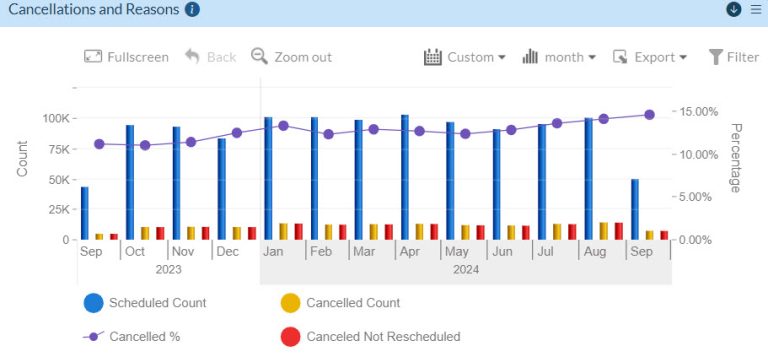
According to the Medical Group Management Association (MGMA), there is a wide range of no-show rates across various medical practices ranging from 5% to 30%, depending on specialty and location. In ophthalmology practices without AI, where patient visits are often scheduled months in advance, these missed appointments leave providers with idle time and fewer opportunities to address patient needs. By using data-driven scheduling strategies, you can ensure schedule density, billings and patient access to keep your ophthalmology practice running smoothly.

The first step in reducing no-shows and cancellations is understanding the patterns in your appointment data. WhiteSpace Health’s platform does this by:



Analyzing historical scheduling data to identify high-risk appointment times and days when cancellations are most likely.
Evaluating patient demographics and trends, such as age and diagnosis, which may influence cancellation tendencies.
Optimizing schedule flow by identifying peak and low-demand times, allowing adjustments to better align with patient preferences.
By adopting ophthalmology scheduling analytics, you are empowered to make informed decisions, maximize provider availability, and ensure efficient operations.

Integrating data-driven analytics into your ophthalmology scheduling brings numerous benefits. Reduced idle provider time and optimized scheduling lead to increased patient throughput and revenue. Moreover, fewer canceled appointments result in more satisfied patients who are likely to receive timely care, while minimizing downtime for providers boosts job satisfaction and enhances operational efficiency.
To fully leverage ophthalmology scheduling analytics in reducing no-shows and cancellations, consider the following strategies. Automated reminders help to prompt patients at ideal times, reducing missed appointments. Predictive analytics can identify high-risk patients, allowing practices to double-book or have standby options ready for last-minute cancellations. Capacity adjustments based on peak demand times and seasonal trends further refine scheduling, ensuring resources are always aligned with patient needs.
Real-time analytics also empower your team to make immediate adjustments as soon as cancellations or no-shows occur. This flexibility prevents valuable provider time from going unused and allows for smooth scheduling even during busy seasons.
WhiteSpace Health’s platform provides dynamic, data-driven dashboards that empower your practice to monitor and respond to scheduling challenges in real time. With KPI tracking, you can monitor metrics such as no-show and cancellation rates, as well as time taken to fill open slots. Capacity utilization metrics allow you to visualize provider schedules and make on-the-fly adjustments. This real-time capability streamlines your practice operations, improving efficiency and responsiveness. Key features include:
Monitor metrics such as no-show rates, cancellation rates, and average time to fill canceled slots.
Visualize provider utilization rates, allowing your team to adjust schedules to avoid over- or under-booking.
Real-time insights enable your staff to proactively manage cancellations and open slots.
For many practices, the shift to data-driven scheduling may seem daunting. Common challenges include training staff to interpret and act on data insights effectively, overcoming resistance to change from traditional scheduling practices, and balancing the initial investment in analytics technology with long-term revenue gains. WhiteSpace Health addresses these obstacles by offering user-friendly interfaces, comprehensive training resources, and a dedicated support team to help your practice integrate ophthalmology scheduling analytics seamlessly.

Predictive analytics and data-driven insights are more than just buzzwords; they are transformative tools reshaping healthcare scheduling. By implementing these tools in your ophthalmology practice, you can minimize cancellations, optimize provider utilization, and improve the patient experience. WhiteSpace Health’s platform equips you with the ability to monitor, analyze, and adjust your scheduling in real time, delivering sustainable improvements in efficiency and profitability.
The move toward predictive scheduling and data-driven analytics is reshaping how ophthalmology practices manage patient appointments. By partnering with WhiteSpace Health, you can take advantage of these powerful tools to improve patient access, provider utilization, and financial outcomes. Don’t let no-shows and cancellations keep your practice from reaching its full potential. Start using data to drive your ophthalmology scheduling decisions and witness improvements in efficiency, patient satisfaction, and revenue.

Ivan Bradshaw is the vice president of product management at WhiteSpace Health. As a revenue cycle management executive with over 20 years of experience, Ivan is adept at building high-performance teams and creating RCM solutions that stop revenue leakage, improve operational efficiency, and grow top line performance.

2424 North Federal Highway, Suite 205
Boca Raton, FL 33431